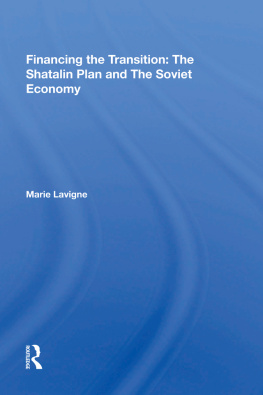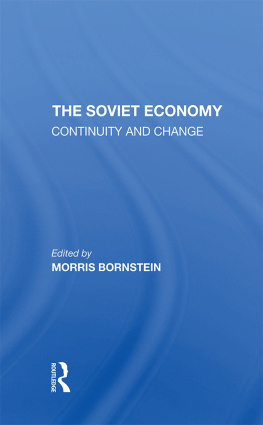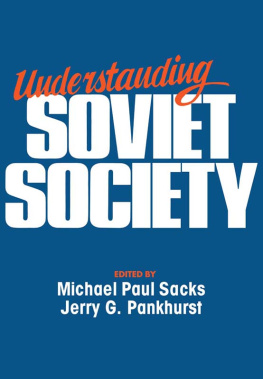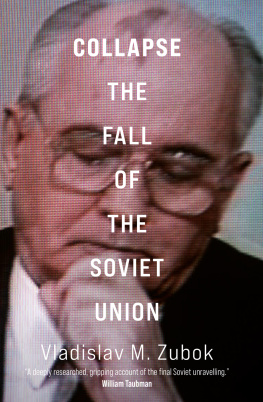First published 1991 by Westview Press
Published 2018 by Routledge
52 Vanderbilt Avenue, New York, NY 10017
2 Park Square, Milton Park, Abingdon, Oxon OX14 4RN
Routledge is an imprint of the Taylor & Francis Group, an informa business
Copyright 1991 by the Institute for East-West Security Studies.
All rights reserved. No part of this book may be reprinted or reproduced or utilised in any form or by any electronic, mechanical, or other means, now known or hereafter invented, including photocopying and recording, or in any information storage or retrieval system, without permission in writing from the publishers.
Notice:
Product or corporate names may be trademarks or registered trademarks, and are used only for identification and explanation without intent to infringe.
Library of Congress Cataloging-in-Publication Data
Lavigne, Marie, 1935-Financing
the transition in the USSR: the Shatalin plan and the
Soviet economy / Marie Lavigne
p. cm.(Public policy papers)
Includes bibliographical references.
ISBN 0-913449-23-7: $7.85.ISBN 0-8133-8279-3 (Westview): $7.85
1. Soviet UnionEconomic policy1986- 2. Shatalin, S.S.
(Stanlislav Sergeevich) I. Title. II. Series: Public policy papers (Institute
for East-West Security Studies)
HC336.26.L38 1990
338.947dc20 90-26221
CIP
ISBN 13: 978-0-367-01635-7 (hbk)
For 70 years the Soviet Union preached the moral and economic success of its centrally planned system; the early spectacular rise of socialism's mother state seemed to epitomize the inherent weaknesses of the West's economic tenets and the inevitable dominance of the Marxist creed. Much of this success was merely a facade, however. The powerful Soviet state has ossified slowly over the past 20 years, and as its satellites break away to embrace the West, the USSR finds itself disintegrating even more rapidly as decades of bureaucratic ineptitude come bursting to the surface. In the midst of Moscow's leadership crisis Mikhail Gorbachev, in an uncharacteristic gamble designed to retain his increasingly tenuous hold over the strained union, has acknowledged the failure of the state-controlled economy and announced an ambitious effort to adopt a market-based system to reverse the precipitous decline of all aspects of the nation.
Marie Lavigne, a highly respected professor of international economics at the University of Paris, examines this so called October (or "Presidential") plan, which is Gorbachev's compromise program, and compares it to the more well-known radical and ground-breaking 500-day transition developed by Stanislav Shatalin and trumpeted by Boris Yeltsin's Russian Republic. It is clear only that the task of economic stabilization will prove to be more arduous than previously thought, regardless of which plan is implemented.
As Dr. Lavigne points out, the Shatalin plan is useful now primarily as an analytical tool that offers the first frank discussion of the ills of the Soviet economy and defines specific remedies geared toward greater privatization and economic reform. The program was flawed in several areas, most notably in its directives on devolving responsibility to unformed, hostile and powerless republic governments; also, Shatalin's insistence on strict sequencing of reform procedure would most likely hinder the process if applied rigidly. But the issues addressedruble convertibility, destatization, foreign investmerit, the creation of financial markets, etc.are consistent in any potential transition process, and by recognizing the unworkable elements it may be possible to develop a more viable comprehensive reform option.
The gradual approach, or October plan, is riot such a panacea, however. It suffers from its own vagueness, especially in its hollow discussion of "main directions," and, more importantly, it lacks strong political support because it is viewed as a compromise gesture. The goals of stabilization and rejection of the centrally planned economy remain the same as in Shatalin's program, but without the same deadlines. Gorbachev, by promoting this more cautious approach, would also have the individual republics handle the specific details; therefore, it is obvious that the program will not work if not embraced by the entire unionRussia has already declared its preference for the original Shatalin provisions, so it may seem as though the October plan is already proving its skeptics correct.
Whatever the consequences, it is imperative that the Soviet Union attempt stabilization measures to prevent a total collapse of what remains of the moribund economy. Western aid will be forthcoming only if a clear commitment to democratization and a freely functioning market economy are visible in the actions of the Soviet leadership. In the short term, this aid is necessary to stave off basic problems such as famine and explosive ethnic unrest; in the long run, it will help guide the nation, either as a whole or at the newly independent republic level, toward greater prosperity and closer ties with the more developed Western economies. The Shatalin plan provides the first comprehensive analysis of the present Soviet economic situation, and though it will not be implemented entirely, it exists as proof to the West that there is genuine alarm within the USSR and that remedies ranging from Polish "shock-therapy" to Ryzhkov gradualism are being considered. Once clear responsibility and vision are established, it may then be possible to tackle specific economic issues and institute a workable transition and program of reform.
Dr. Lavigne worked on this book while serving as a Resident Fellow at the Institute for East-West Security Studies from May to October 1990. She would like to thank Bela Balassa, Joel Dirlam, John Hardt, David Kemme, Mario Nuti and John Tedstrom for their help and support, and she takes full responsibility for the content and style of the paper.
Thanks are due to the following philanthropic foundations for their generous support of IEWSS programs: The Ford Foundation; The William and Flora Hewlett Foundation; The Alfried Krupp von Bohlen und Halbach Foundation; The John D. and Catherine T. MacArthur Foundation; The McKnight Foundation; The Rockefeller Family and Associates; The Rockefeller Foundation; The Scherman Foundation; The Florence and John Schumann Foundation; and the Weyerhaeuser Foundation, Inc.
Along with the author, the Institute for East-West Security Studies wishes to express gratitude to the following members of its staff for their work on this publication: Richard Levitt, Director of Publications; Rosalie Kearns, Publications Editor and Jeff Hoover, Publications Associate.
John Edwin Mroz
President
Institute for East-West Security Studies
December 1990
Working in a summer house day and night in August 1990, a team of 13 Soviet economists, together with representatives of all the Soviet sovereign republics but one (Estonia), drafted a program that was intended to lead the USSR toward a market economy. The leader of the team was academician Stanislav Shatalin, a mathematician-economist specializing in macroeconomic modeling, and a member of the Communist Party's Central Committeethough he sees himself more as a social democrat. The Shatalin program was adopted in September 1990 by the Supreme Soviet of the Russian Republic. It was not discussed as such by the Supreme Soviet of the Union, but the plan proposed to that body was a compromise between the Shatalin project and a much less radical plan drafted by the Ryzhkov government, with reconciliation of both programs provided by President Gorbachev. The Shatalin blueprint was meant to end the country's economic crisis and to begin the restructuring of the state economy in 500 days, starting in October 1990. The newer plan has the same goals, but lacks Shatalin's firm deadlines; its implementation may last years, merely outlining the "main directions" of transition, while the details are provided by each republic separately. The only firm commitment is to reach a primary goal, stabilization, in one and a half or (as a maximum) two years. This plan is referred to hereinafter as the October plan (it was adopted on October 19 by the Supreme Soviet), or the Presidential plan.









